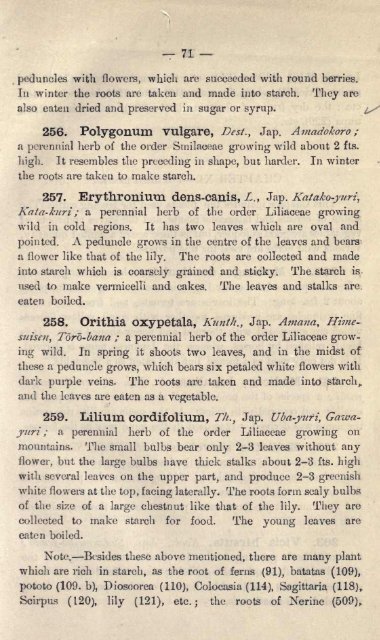Untitled - Library
Untitled - Library
Untitled - Library
Create successful ePaper yourself
Turn your PDF publications into a flip-book with our unique Google optimized e-Paper software.
71<br />
peduncles with flowers, which are succeeded with round berries.<br />
In winter the roots are taken and made into starch. They are<br />
also eaten dried and preserved in sugar or syrup.<br />
256. Polygonum VUlgare, Dcst. t<br />
Jap. Amadokoro ;<br />
a perennial herb of the order Smilaceae growing wild about 2 fts.<br />
high. It resembles the preceding in shape, but harder. In winter<br />
the roots are taken to make starch.<br />
257. Erythronium dens-canis, /.., Jap. Katako-yuri,<br />
Kata-kuri ; a perennial herb of the order Liliaceae growing<br />
wild in cold regions. It has two leaves which are oval and<br />
pointed. A peduncle grows in the centre of the leaves and bears<br />
a flower like that of the lily.<br />
The roots are collected and made<br />
into starch which is coarsely grained and sticky. The starch is<br />
used to make vermicelli and cakes. The leaves and stalks are;<br />
eaten<br />
boiled.<br />
258. Orithia oxypetala, Kunth., Jap. Amana, Himesniseti)<br />
Toro-bana ; a perennial herb of the order Liliaceae growing<br />
wild. In spring<br />
it shoots two leaves, and in the midst of<br />
these a peduncle grows, which bears six petaled white flowers with<br />
dark purple veins. The roots are taken and made into starch,,<br />
and the leaves are eaten as a vegetable.<br />
259. Liliuin cordifolium, T/i., Jap. Uba-ynri, Gaivaynri<br />
; a perennial herb of the order Liliaceae growing on<br />
mountains. The small bulbs bear only 2-3 leaves without any<br />
flower, but the large bulbs have thick stalks about 2-3 fts. high<br />
with several leaves on the upper part, and produce 2-3 greenish<br />
white flowers at the top, facing laterally. The roots form scaly bulbs<br />
of the size of a large chestnut like that of the lily. They are<br />
collected to make starch for food. The young leaves are<br />
eaten boiled.<br />
Note. Besides these above mentioned, there are many plant<br />
which are rich in starch, as the root of ferns (91), batatas (109),<br />
pototo (109. b), Diosoorea (110), Colocasia (114), Sagittaria (118),<br />
Scirpus (120), lily (121), etc.; the roots of Nerine (509),
















